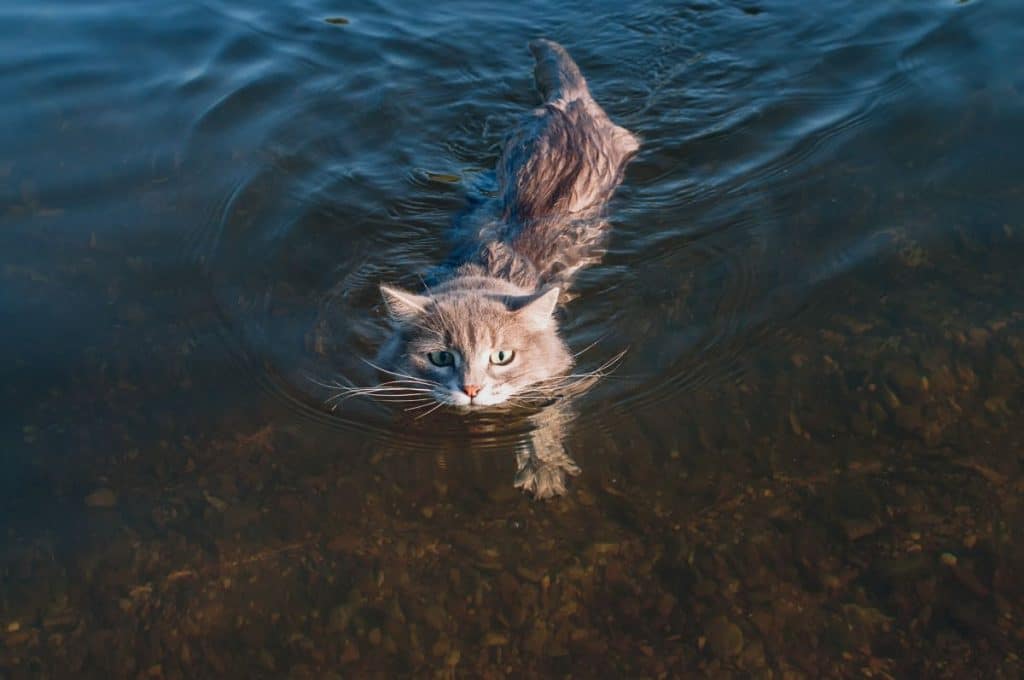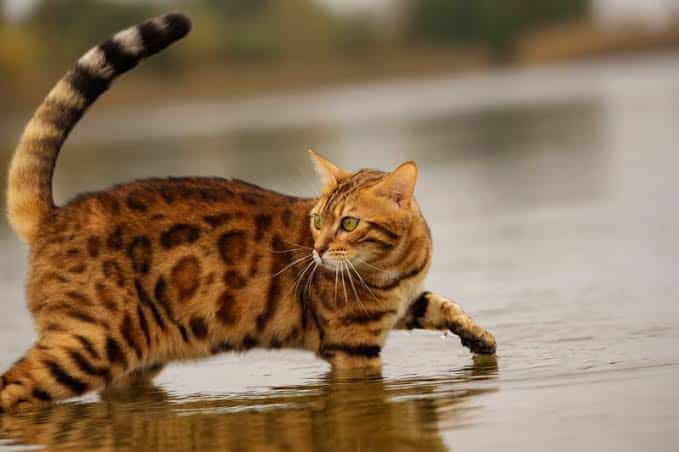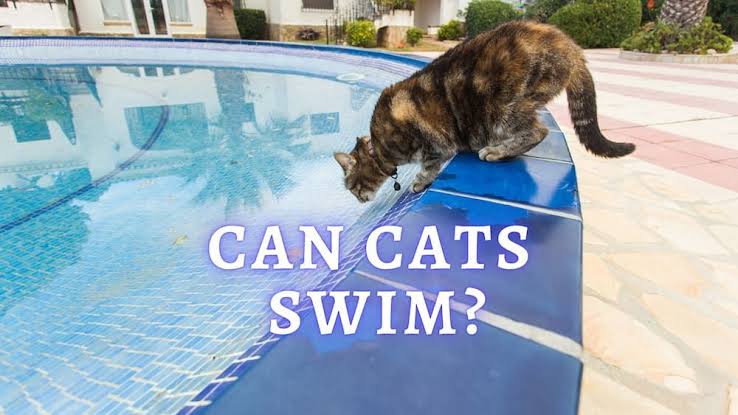Cats, with their graceful agility and independent nature, have captivated human hearts for centuries. Yet, amidst the countless myths and mysteries surrounding our cats, one question often arises: Can Cats Swim?. In this article, we will uncover about the depths of this age-old query, uncovering the truth behind cats and water.
The Myth vs. Reality Of Cats And Water
For centuries, cats have been associated with an aversion to water. This common belief has been perpetuated through folklore, cultural anecdotes, and even popular media. However, when it comes to the truth about cats and water, there’s more to the story than meets the eye.
Myth: Cats Hate Water
Reality: While it’s true that many cats prefer to avoid water, not all cats share the same sentiment. In fact, some breeds, such as the Maine Coon and the Turkish Van, have been known to enjoy water activities. Additionally, individual cats may have varying levels of comfort or curiosity when it comes to water, influenced by factors like early experiences, genetics, and personality.
Myth: Cats Can’t Swim
Reality: Contrary to popular belief, cats are capable swimmers when necessary. Their natural instincts kick in, and they can paddle their way to safety if faced with a water-related emergency. However, it’s essential to note that not all cats are enthusiastic swimmers, and some may require assistance or encouragement to navigate water confidently.
Myth: Cats Avoid Water At All Costs
Reality: While many cats may prefer to keep their paws dry, they are not inherently opposed to water. Some cats may enjoy playing with dripping faucets, splashing in shallow puddles, or even lounging in a warm bath.
Myth: Bathing Cats Is Cruel
Reality: Bathing a cat can be challenging due to their aversion to water and sensitivity to unfamiliar experiences. However, regular grooming and occasional baths are essential for maintaining their coat and skin health, especially for long-haired breeds. With patience, positive reinforcement, and proper techniques, bathing can be a stress-free experience for both cats and their owners.
Recommended: What Colors Can Cats See

Understanding Cat Anatomy And Adaptations
To truly comprehend cats’ relationship with water, it’s essential to delve into their anatomy and evolutionary adaptations. While cats may not be renowned for their aquatic prowess, their physical characteristics provide insights into their capabilities in water.
Body Structure
Cats possess a sleek and streamlined body shape, ideal for swift movement on land. However, this design also aids in navigating through water with minimal resistance. Their flexible spine and powerful limbs allow for efficient propulsion while swimming.
Paws and Claws
The structure of a cat’s paw is another fascinating adaptation. Unlike webbed feet found in many aquatic animals, cats have retractable claws that offer traction on various surfaces, including wet ones. This feature enables them to grip and propel themselves through water effectively.
Water-Repellent Coat
A cat’s fur serves as more than just a fashion statement. It plays a crucial role in regulating body temperature and repelling water. The outer layer of a cat’s coat is designed to prevent water from penetrating down to the skin, keeping them relatively dry even after brief exposure to water.
Buoyancy Control
Cats are naturally buoyant creatures, thanks to their low body density and air-filled lungs. This buoyancy allows them to stay afloat effortlessly, conserving energy while swimming. Additionally, cats can adjust their body position to maintain stability in the water, further enhancing their swimming abilities.
Instinctual Behaviors
While cats may not have evolved to be aquatic specialists like seals or otters, they possess instinctual behaviors that aid in water survival. These include the ability to tread water, paddle with their paws, and hold their breath for short periods when submerged.
Adaptability
Despite their ancestral origins in arid environments, cats have demonstrated remarkable adaptability to various habitats, including those with water sources. This adaptability is evident in domestic cats’ willingness to explore and interact with water, albeit on their terms.
Real-Life Examples: Cats In Water
While the stereotype of cats shunning water may prevail, real-life examples offer a more nuanced perspective on feline interactions with aquatic environments. From playful antics to life-saving maneuvers, cats have been known to surprise us with their behavior in water.
Natural Curiosity
Despite their reputation as land-loving creatures, many cats exhibit a natural curiosity towards water. Whether it’s investigating a dripping faucet or batting at ripples in a pond, cats’ inquisitive nature often leads them to explore water sources in their environment.
Fishing Skills
Certain cat breeds, such as the Turkish Van, have gained notoriety for their exceptional fishing abilities. Originating from the rugged terrain of Eastern Turkey, these cats have evolved to be proficient swimmers and skilled hunters of fish. Their love for water and hunting instincts make them well-suited for life near rivers and lakes.
Water Play
Contrary to popular belief, some cats thoroughly enjoy water play. From splashing in shallow pools to frolicking in the bathtub, these water-loving felines embrace aquatic activities with enthusiasm. Videos of cats diving into water or chasing toys in swimming pools have garnered millions of views online, showcasing their playful side.
Swimming Skills
While not all cats are avid swimmers, many possess the instinctual ability to paddle their way to safety if necessary. Instances of cats accidentally falling into water and successfully swimming to shore are not uncommon. Their agile bodies and natural buoyancy enable them to navigate through water with surprising grace and efficiency.
Adventurous Explorations
Cats are known for their adventurous spirit, and water is no exception. Whether it’s crossing a shallow stream or boldly wading into a pond, cats have been observed exploring water bodies in pursuit of new experiences or prey. Their cautious yet curious approach to water reflects their innate curiosity and adaptability.
Emergency Situations
In emergency situations such as floods or accidents, cats have demonstrated remarkable survival instincts in water. Stories of cats rescuing themselves or their owners from drowning by swimming to safety serve as powerful reminders of their resilience and resourcefulness in the face of adversity.
Recommended: How to Know When a Cat is Pregnant: Symptoms Of Early Pregnancy in Cats
Tips For Introducing Cats To Water
Introducing a cat to water can be a difficult task, especially if they have a natural aversion to it. However, with patience, positive reinforcement, and gradual exposure, many cats can learn to tolerate and even enjoy water activities. Below are the tips:
1. Start Slowly
Begin by introducing your cat to water in a gentle and non-threatening manner. Offer shallow bowls of water for them to investigate or place a damp cloth on their fur during grooming sessions to familiarize them with the sensation of water.
2. Use Positive Reinforcement
Reward your cat with treats, praise, or playtime for showing curiosity or calm behavior around water. Positive reinforcement helps create a positive association with water and encourages your cat to feel more comfortable and confident.
3. Create A Safe Environment
Ensure that the water temperature is comfortable and the environment is free from distractions or potential hazards. Use a shallow basin or sink for initial water introductions, providing easy access and a secure footing for your cat.
4. Use Toys And Treats
Incorporate toys, floating objects, or treats into water play sessions to make them more engaging and enjoyable for your cat. Interactive toys that encourage batting or chasing can help distract and motivate your cat while in the water.
5. Respect Your Cat’s Boundaries
Pay attention to your cat’s body language and signals to avoid overwhelming or stressing them during water introductions. If your cat shows signs of discomfort or fear, take a step back and try again later with a more gradual approach.
6. Offer Support And Reassurance
Be patient and supportive during the water introduction process, offering gentle reassurance and comfort to your cat. Speak in soothing tones, pet them calmly, and avoid forcing or restraining them if they show resistance.
7. Gradually Increase Exposure
Gradually increase the duration and depth of water exposure as your cat becomes more comfortable and confident. Start with short, supervised sessions and gradually extend the time spent in the water as your cat’s tolerance and confidence grow.
8. Consider Professional Grooming Services
If bathing your cat at home proves to be too challenging, consider seeking professional grooming services that specialize in handling cats. Professional groomers have the experience and expertise to safely and effectively bathe cats while minimizing stress and anxiety.
The Science Behind Cat Behavior In Water
Understanding the science behind cat behavior in water offers valuable insights into why cats react the way they do when faced with aquatic environments. While cats may have a reputation for avoiding water, their behaviors and reactions are rooted in instinctual and physiological factors:
Evolutionary Origins
Cats are descendants of desert-dwelling ancestors, whose survival depended on conserving water and avoiding moist environments. This evolutionary history has shaped cats’ natural aversion to water and their preference for staying dry whenever possible.
Fear Response
When confronted with unfamiliar or potentially threatening stimuli, cats may exhibit a fear response, which can manifest as avoidance, anxiety, or aggression. Water, being a foreign and unpredictable element, can trigger this fear response in many cats, leading to behaviors like fleeing or vocalizing in distress.
Sensory Sensitivity
Cats have highly sensitive sensory receptors in their skin and fur, which can make them acutely aware of changes in temperature, texture, and moisture. The sensation of wet fur or water droplets on their skin may be uncomfortable or unpleasant for some cats, leading them to avoid water-related activities.
Temperature Regulation
Cats are adept at regulating their body temperature, primarily through behaviors like grooming and seeking out warm or cool environments. Water exposure can disrupt this delicate balance, especially if the water is too cold or if the cat becomes soaked and unable to dry off promptly. Avoidance of water may be a means for cats to maintain their thermal comfort and avoid potential health risks associated with temperature fluctuations.
Instinctual Behaviors
Despite their aversion to water, cats retain instinctual behaviors related to survival in aquatic environments. These behaviors include paddling motions with their paws, treading water, and holding their breath when submerged. While these behaviors may not be as pronounced in domestic cats as in their wild ancestors, they serve as vestiges of their evolutionary heritage.
Learned Behaviors
Cats’ reactions to water can also be influenced by past experiences and socialization during kittenhood. Cats that have positive experiences with water early in life, such as exposure to baths or swimming, may be more accepting of water-related activities later on. Conversely, traumatic experiences or lack of exposure to water during critical developmental periods can contribute to a cat’s aversion to water.
Recommended: Melatonin for Cats

Can Cats Float On Water?
The question of whether cats can float on water may seem straightforward, but the answer is more complex than a simple yes or no. While cats are naturally buoyant creatures, their ability to float depends on various factors, including their body composition, water density, and individual behaviors:
Buoyancy
Cats have a relatively low body density and air-filled lungs, which contribute to their natural buoyancy. In other words, they are less dense than water, allowing them to float effortlessly on the surface. This buoyancy is further enhanced by their sleek body shape and water-repellent fur, which minimize resistance and help keep them afloat.
Body Composition
While most cats possess the innate ability to float, individual variations in body composition can influence their buoyancy. Leaner cats with less body fat may find it easier to float than overweight or obese cats, whose excess weight can make it more challenging to stay buoyant.
Water Density
The density of the water itself also plays a role in determining whether a cat can float. Freshwater is less dense than saltwater, which means that cats may find it slightly easier to float in freshwater environments. However, cats are capable of floating in both freshwater and saltwater, thanks to their natural buoyancy.
Instinctual Behaviors
In addition to their physiological characteristics, cats’ behaviors in water can impact their ability to float. When faced with water, cats may instinctively adopt a paddling motion with their paws to help them stay afloat. This behavior, combined with their buoyant body, allows many cats to remain on the surface of the water without sinking.
Swimming Skills
While floating is one aspect of cats’ behavior in water, swimming is another. While not all cats are enthusiastic swimmers, many possess the instinctual ability to paddle and propel themselves through water when necessary. This swimming ability, coupled with their buoyancy, enables cats to navigate through water with surprising grace and agility.
Frequently Asked Questions
Can All Cats Swim?
While all cats possess the ability to swim to some extent, not all cats are enthusiastic swimmers. Some breeds, such as the Turkish Van and Maine Coon, are known for their affinity for water, while others may be more hesitant or avoidant.
Are Cats Afraid Of Water?
Many cats exhibit a natural aversion to water, which can manifest as fear or reluctance when faced with water-related activities. However, individual cats may have varying degrees of comfort or curiosity when it comes to water, influenced by factors like genetics and early experiences.
Do Cats Need To Be Taught How To Swim?
Cats possess innate swimming instincts and can paddle their way to safety if necessary. However, not all cats are confident swimmers, and some may benefit from gradual exposure and positive reinforcement to become more comfortable in water.
How Can I Introduce My Cat To Water?
Introducing your cat to water should be done gradually and with patience. Start by offering shallow bowls of water for them to investigate, and use positive reinforcement techniques like treats and praise to encourage curiosity and calm behavior around water.
Can I Give My Cat A Bath?
Bathing a cat can be challenging due to their aversion to water and sensitivity to unfamiliar experiences. However, regular grooming and occasional baths are essential for maintaining their coat and skin health. With patience, positive reinforcement, and proper techniques, bathing can be a stress-free experience for both cats and their owners.
Are There Any Risks Associated With Cats And Water?
While many cats can swim and tolerate water-related activities, it’s essential to prioritize their safety and well-being. Avoid exposing cats to strong currents or deep water without supervision, and always provide a safe and secure environment for water play and exploration.
Can Cats Drown In Water?
Cats are generally adept at navigating water and can swim to safety if necessary. However, like any animal, cats can be at risk of drowning if exposed to dangerous or challenging water conditions. It’s crucial to supervise cats during water-related activities and provide assistance if needed.
Are There Any Breeds Of Cats That Are Better Swimmers Than Others?
While individual cats’ swimming abilities may vary, certain breeds are known for their affinity for water and exceptional swimming skills. Breeds like the Turkish Van and Maine Coon have a reputation for being natural-born swimmers, thanks to their water-resistant coats and adventurous personalities.
Recommended: Are Pothos Toxic to Cats?
Conclusion
While cats are inherently capable of swimming due to their natural buoyancy and instincts, their attitudes toward water can vary greatly. Some cats may embrace water playfully, while others may avoid it altogether.
Understanding cats’ behaviors and abilities in water is essential for cat owners to ensure their pets’ safety and well-being. Whether introducing a cat to water for the first time or supervising them during water-related activities, patience, positive reinforcement, and respect for their preferences are key.

